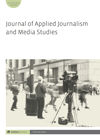
Full text loading...

 , André Corrêa d’Almeida1
, André Corrêa d’Almeida1 , Lindsay Green-Barber2
, Lindsay Green-Barber2 , Adelina Yankova1
, Adelina Yankova1 , Dylan W. Groves3
, Dylan W. Groves3
How should we measure the impact of investigative journalism? Media scholars and practitioners have turned their attention towards understanding the causal effect of media reports on a range of social, political and economic outcomes. Their interest has been spurred by the increased availability of data, by the emergence of new tools for rigorously assessing causal effects and by pressure from donors interested in understanding the returns on their investments in media and journalism programmes. Drawing on literature from multiple disciplines, we propose a multi-faceted metric which future researchers, journalists and news agencies will be able to use when analysing media impact.

Article metrics loading...

Full text loading...
References


Data & Media loading...
Publication Date:
https://doi.org/10.1386/ajms_00121_1 Published content will be available immediately after check-out or when it is released in case of a pre-order. Please make sure to be logged in to see all available purchase options.